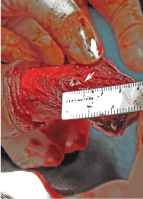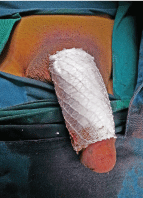The objective of the study was to highlight the epidemiology, aetiology, presentation, diagnosis and outcomes of penile fracture in China.
Except reporting eight cases, we also retrieved literatures from Chinese publications between January 1984 and July 2017. Data extracted included authors, regions and year of publication, aetiology, clinical features, diagnosis, treatment and outcome.
In 113 publications 984 cases (including our eight cases) were retrieved. An annual incidence in China has been estimated between 0.002/million and 0.2/million male populations. The commonest causes were coitus and masturbation. Clinical features were the classical triad of "cracking" sound, immediate detumescence and pain. Swelling, ecchymosis and deformity were present in the majority of patients. Diagnosis was made mainly on clinical grounds; ultrasonography can be very helpful in equivocal cases. Concomitant urethral injury accounted for 6.3% of all cases. Treatment options were surgery and conservative in 92.2% and 7.8% patients, respectively. Early surgical repair was advocated because a higher incidence of complications was found in conservatively treated patients. Complications of the injury included penile curvature, nodules, infection, painful coitus, urethral fistula, and erectile dysfunction.
Penile fracture may be underreporting which can usually be diagnosed based solely on history and physical examination findings. Early surgical repair is obviously preferable option because of excellent results even in the presence of urethral injury.
Penile fracture, Aetiology, Diagnosis, Treatment, China
Penile fracture (PF) is an uncommon urological emergency, and urethral injury may be involved concomitantly. The causes include coitus, masturbation, penile manipulation, rolling in bed and blunt trauma. Penile rupture can usually be diagnosed based solely on history and physical examination findings; however, in equivocal cases, diagnostic ultrasonography (US) or magnetic resonance imaging (MRI) should be performed [1]. Currently surgical intervention has become a mainstay of the treatment, owing to its better outcomes and fewer complications. However, to our knowledge, there is no review regarding epidemiology, aetiology, symptoms and outcomes of treatment following PF from China. The aim of this study was to explore PF aetiologies, clinical presentation, diagnosis, management, and outcome in China and to objectively verify whether geographic differences exist.
The study was approved by the Ethics Committee of the hospital. Written informed consent was obtained from each patient. During the 2003 to 2016 period, eight patients with PF were admitted to our hospital. The mean age was 33.6 years. The mean interval from injury to surgical intervention was 9.6 hours. The clinical date of the patients was shown in Table 1. Except for one patient refusal to surgery, seven patients received immediate surgical therapy using a degloving incision by two senior urologists (Figure 1, Figure 2 and Figure 3). The patients were discharged 10 to 14 days after treatment. Mean follow-up time was 89.5 months. The international index of erectile function (IIEF-5) was used to assess erectile function. 7 patients reported high confidence in their ability to maintain an erection for sexual intercourse without sequelae in follow-up (Figure 4), the average score was 23.7. However, the remaining one patient treated conservatively had difficulty in coitus because of severe curvature penis and pain (IIEF-5 scoring was 15). Furthermore, using the terms "penile fracture", "penile trauma" by means of search engines of "China Hospital Knowledge Database (CHKD)" and "China National Knowledge Infrastructure (CNKI)", totally 138 articles about PF were retrieved between January 1984 and July 2017, of which 113 publications 948 patients were selected to review. The inclusive criteria were: (1) Patients reported from domestic publications; (2) Diagnosis as penile fracture clinically and confirmed surgically; (3) The records included clinical manifestations, imaging data, site and side of rent, treatment methods and outcomes. Exclusive criteria were overlap or incomplete information.
 Figure 1: Typical penile deformity, swelling and ecchymosis in a patient with penile fracture (“eggplant” deformity).
View Figure 1
Figure 1: Typical penile deformity, swelling and ecchymosis in a patient with penile fracture (“eggplant” deformity).
View Figure 1
 Figure 2: 1 cm rent in the right tunica albuginea in the distal ventral most shaft (white arrow).
View Figure 2
Figure 2: 1 cm rent in the right tunica albuginea in the distal ventral most shaft (white arrow).
View Figure 2
 Figure 3: After repairing, light compressive dressing is applied for one week.
View Figure 3
Figure 3: After repairing, light compressive dressing is applied for one week.
View Figure 3
 Figure 4: After 48 months of follow-up, the penile appearance is normal.
View Figure 4
Figure 4: After 48 months of follow-up, the penile appearance is normal.
View Figure 4
Table 1: Clinical parameters in eight patients with fracture penis. View Table 1
7 out eight patients were a result of sexual intercourse, one involved blunt trauma in the erect penis. All patients complained of penile swelling, severe pain and ecchymosis and presented a typical deformity, or so called "eggplant deformity" (Figure 1). Repairs were performed in seven penile fractures. One was managed conservatively. Clinical outcomes were seen Table 1.
In the study, the total number of reported 948 cases according to hospital region within last four decades in different areas of China was: North China: 50, Northeast China: 156, Northwest China: 45, East China: 239, South China: 190, Southwest China: 129 and Central China: 139 as shown in Figure 5. Mean age was 32.8 ± 5.3 years. The aetiological factors revealed that coitus was reported in 72.5%, penile manipulation in 4.1%, masturbation in 12.8%, blunt trauma in 5.9%, rolling over in bed in 2.5%, hastily removing clothes in 0.8% and unknown cause in 1.3% as shown in Table 2. All patients presented with penile swelling and ecchymosis, 98.4% patients reported hearing a "cracking" sound and pain with immediate detumescence. 97.9% patients had typical deformity of PF. The diagnosis of PF was mainly made by clinical presentation; while penile US investigations were utilized in 22.1% patients and MRI was used in three patients (0.3%) in those equivocal patients. Only 0.1% patient had urethroscope examination. The side and site of the rent during operation were shown on Table 2. The average size of the rent was 1.6 (0.3-3) cm.
 Figure 5: The distribution map of incidence of penile fracture in China.
View Figure 5
Figure 5: The distribution map of incidence of penile fracture in China.
View Figure 5
Table 2: Demography of patients reported in China. View Table 2
PF was treated conservatively in 7.8% and surgically in 92.2% of patients. The results shown that the complication rates for conservative and surgical management were 44.6% and 4.4%, respectively (P = 0.000). Of the operative 874 patients, 47.9% were repaired using a direct incision over the defect and 52.1%, using a degloving circumcision (Table 3). The study shown that the rate of complications of repair using degloving incision was lower than that of direct incision (3.3% vs. 5.5% P = 0.012). There was also lightly significant difference in erectile dysfunction between direct and degloving repairs (1.4% vs. 0.2%, P = 0.045). 96.6% patients underwent early repair (< 24 hours) and 3.4% patients, delayed repair (> 24 hours), respectively. Our study demonstrated that there was a significant difference of complications between early and delayed repair (3.4% vs. 30% P = 0000), and the rate of erectile dysfunction was significantly lower for early surgical repair compared to delayed repair (0.5% vs. 10%, P = 0000). Concomitant urethral injury was reported in 60 cases (6.3%), was closed either by direct suture or individually with an end to end anastomosis. There was one urethrocutaneous fistula in each surgical approach (P = 0.095), and they were resolved spontaneously after urethral catheterization. A comparison of complications between surgically and conservatively treated patients was shown in Table 4. 85% patients were followed; the mean period of follow-up was 17.8 m (7 d-156 m) months.
Table 3: Comparison of complication rate between conservative and surgical management. View Table 3
Table 4: Comparison of complications of reported penile fracture cases according to different management. View Table 4
PF is initially regarded as a relatively rare injury. However, the incidence of PF is likely underreported, the actual frequency is not as rare as has been claimed. The incidence of PF remains obscure worldwide. In Iran, the incidence of PF was reported to be estimated between 1.14 to 10.48 per 100,000 male populations [2]. In this study, we found that there was a significant difference in incidence among different geographical regions of China. An annual incidence of PF in China has been estimated between 0.002/million and 0.2/million male populations, which was much lower than that in Iran and Middle East. Of course, we know that the real incidence may be higher than aforementioned, because it is underreported or hidden probably because of social embarrassment and sociocultural characteristics. Moreover, penile fracture may occur frequently in "stressful situation" such as extramarital sex, this injury may also lead to "social stigma", resulting in a delay or avoidance of seeking medical treatment.
The percentage of aetiology of PF has long been known to differ among various geographic areas. In the United States and Europe [3,4], the majority of cases resulted from coitus. Interestingly, more than half of the reported PF in Middle East, especially in Iran, were usually caused by "Taqaandan", a common practice by "kneading" and "snapping" the erect penis to achieve rapid detumescence [5]. In China, the highest proportion of the disease was sexual intercourse, other causes were shown in Table 2. Reis, et al. [6] reported that "woman on top" position was the most common situation seen in fifty percent of cases, followed by "doggy style". By contrast, Barros, et al. [7] found that the "doggy style" (41%) and the "man-on-top" (23%) positions in coitus were the commonest cause of PF and more frequently associated with bilateral fractures of the corpus cavernosum and urethral lesions. These studies demonstrated that the sexual position did have an impact on the relative risk of PF.
The clinical presentation of PF is often fairly straightforward. Diagnosis can be made solely based on history and physical examination findings. In our study, clinical manifestations were the classic triad of an audible crack, detumescence and pain. The site of the rent was usually transverse and unilateral, the right side was easier to be involved than the left one. The site of the rent was mostly proximal 1/3, followed by middle 1/3 and distal 1/3 of the penis. There was no clear explanation for this reason, because there was a paucity of data regarding the site and the side of PF. The incidence of urethral injury was reported to be only 6.3% in China, as compared with 20-38% in the United States and in Europe [8,9]. Presumably the possibility of low rate urethral injury in China was likely to be associated to culture, religious, position and force involved in coitus.
The management of PF had been highly controversial until the early 1980's. Conservative management was associated with significant complications such as delayed chordee, coital difficulty, arterial-venous fistulas, penile plaque and erectile dysfunction, which can occur in as much as 30-53% of cases [2,10-13]. It has been found that complications such as penile curvature, nodules, and painful erection were proved to be significantly higher and severer in patients managed conservatively in our study (Table 3). At present, surgical approach options include: Direct incision, degloving incision and inguinoscrotal incision. A direct longitudinal incision over the rent is simple but may be associated with poor cosmesis and recurrence. A degloving incision allows excellent exposure of the three corpora, but may be complicated by abscess, skin necrosis or decrease of sensation. An inguinoscrotal incision may be advocated for proximal fracture and for those occasions when penile oedema is marked enough to threaten skin viability, but wound infection may result in an ugly scar as well as penile angulation. Given high incidence of concomitant urethral injury associated with bilateral corporeal ventral PF, most authors advocated degloving incision. In our series, the two procedures of degloving and direct incision were performed, the complications in the former were much lower than those in the latter. Furthermore, Qian, et al. [14] reported that three rare cases had three episodes of recurrent PF at the same place in the interval of ten months after first repair using direct incision. This may be attributed to poor exposure and inadequate sutures, which resulted in Buck’s fascia and tunica albuginea destroyed and weakened after repair repeatedly. To our knowledge, no publication has solely addressed the rare recurrent penile fracture after repair using direct incision that required a fourth operation. Consequently, we advocated a circumferential degloving incision for the first repair of the injury.
Although surgical repair achieves significantly better outcomes, the optimal timing subsequent intervention, however, has caused some debate. A meta-analysis review identified no statistical difference between timing of PF repair (early [< 24 hours from injury to presentation/surgery] vs. delayed [> 24 hours]) and rates of erectile dysfunction and tunical scar formation [15]. However, Asgari, et al. [16] shown that 3 out of 32 patients (9.4%) treated surgically developed penile curvature and painful coitus (6.2% and 3.2%, respectively), who underwent repair more than 48 hours after injury. Nason, et al. [4] reported that 12.5% patients with mild to moderate erectile dysfunction were noted in PFs repaired more than 24 hours after injury. Song, et al. [17] and Li, et al. [18] reported that delay repair (> 24 hours) was directly related to late postoperative complications. The higher rates of complications in delayed repair may be usually attributable to a residual fibrotic area by delayed process. Consequently, as recommended by the European Association of Urology (EAU) and the American Association of Urology (AAU), surgical intervention should be considered by the urologist as early as possible within 24 hours after injury. Our study further demonstrated that early surgical repair had much better outcomes than delayed repair.
It was found that the cases number of PF reported in China varies significantly in different regions. The coastal economic developed provinces account for 61.7% of all cases. The incidence of PF has been estimated between 0.002/million and 0.2/million male populations. Vigorous coitus was the most common cause. Diagnosis can be made mainly by history and clinical examination. Concomitant urethral injury accounted for 6.3% of all patients. Early repair using circumferential degloving incision was strongly recommended. The present study also highlighted a situation where early surgical repair was undertaken with much better results than delayed management. Future multi-center randomized controlled trial comparing large number of cases of early and delayed surgery is needed to objectively assess long-term outcomes.
The authors declare no conflicts of interest at all.